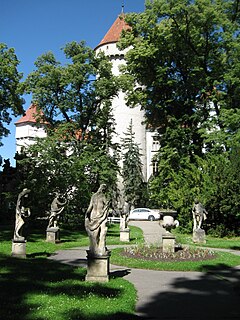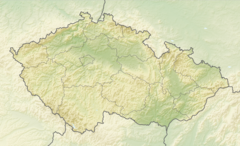Konopiště

 Clash Royale CLAN TAG#URR8PPP
Clash Royale CLAN TAG#URR8PPP
| Konopiště | |
|---|---|
 View of the garden outside the castle. | |
 Location in the Czech Republic | |
| General information | |
| Type | Château |
| Architectural style | Renaissance-Gothic |
| Location | Benešov, Central Bohemia |
| Country | Czech Republic |
| Coordinates | 49°46′46″N 14°39′24″E / 49.77944°N 14.65667°E / 49.77944; 14.65667Coordinates: 49°46′46″N 14°39′24″E / 49.77944°N 14.65667°E / 49.77944; 14.65667 |
| Website | |
| Konopiště Château | |
Konopiště (Czech pronunciation: [ˈkonopɪʃcɛ]; German: Konopischt) is a four-winged, three-storey château located in the Czech Republic, about 50 km (30 mi) southeast of Prague, outside the city of Benešov. It has become famous as the last residence of Archduke Franz Ferdinand of Austria, heir to the Austro-Hungarian throne, whose assassination in Sarajevo triggered World War I. The bullet that killed him, fired by Gavrilo Princip, is now an exhibit at the castle's remote museum.
Contents
1 History
2 Tourist attractions
3 People
4 Notes
5 External links
History

The château as seen from the lake.
The castle was apparently established in the 1280s by Prague Bishop Tobiaš as a Gothic fortification in the style of a French castle with a rectangular plan and round towers protruding from the corners, making the most effective defence possible.[1] Accounts show that the Benešévic family from nearby Benešov were the owners in 1318, and that in 1327 the castle passed into the hands of the Šternberks. In 1468, it was conquered by the troops of George of Poděbrady after a siege that lasted almost two years.
In 1603, the estate was purchased by Dorota Hodějovská of Hodějov, who made Renaissance alterations to the old gothic fortification.[2] The Hodějovský family fortified their property because of their active participation in the anti-Habsburg rebellion in 1620. Albrecht von Waldstein acquired the castle, and after him it was passed to Adam Michna of Vacínov. Michna gained notoriety through his repression of the serfs, who revolted against him and conquered Konopiště in 1657.
The Swedes occupied and plundered Konopiště in 1648, and the Vrtba family then purchased the dilapidated structure. After 1725, they had it transformed into a Baroque style château.[2] The drawbridge was replaced by a stone bridge, and near the east tower a new entrance was inserted in the wall. The gate which embellished it was designed by František Maxmilián Kaňka and featured statues from the workshop of Matthias Bernard Braun. In 1746, the upper levels of four of the towers were destroyed and one tower was completely demolished. During repair of the interiors, mythological and allegorical frescoes were painted on the ceilings of the great hall, and marble fireplaces with carved decorations by Lazar Wildmann were created.
Archduke Franz Ferdinand of Austria bought Konopiště in 1887 with his inheritance from the last reigning Duke of Modena. He had it repaired between 1889 and 1894 by the architect Josef Mocker into a luxurious residence, suitable for a future Emperor, which he preferred to his official residence in Vienna. The extensive 225 ha English-style park, with terraces, a rose garden and statues, was established at the same time.[2]
He invited Wilhelm II, German Kaiser to see his roses early in June 1914. Insofar as they discussed politics, they discussed Romania, but conspiracy theories about their planning an attack on Serbia or a division of the Austro-Hungarian Empire arose at the time and since. After the Archduke's assassination, later in the month, the memory of this visit might have moved the Emperor to give Austria more rein in dealing with Serbia than he had in the Bosnian crisis of 1909.[3]
Since 1921, the castle has been the property of the Czechoslovak and later Czech state, one of 90 such properties in state ownership. The Ministry of Culture is said to spend more than US$ 800,000 per year to maintain the castle, and it recovers about as much from entrance ticket sales and rental fees for occasional functions.[4]
Currently, HSH Princess Sophie von Hohenberg, a descendant of Franz Ferdinand, is claiming for the restitution of the castle to her family (which was never recognized as part of the House of Habsburg), on the grounds that the provisions of Article 208 of the Treaty of Saint Germain, and Article 3 of Law no. 354 of 1921 in Czechoslovakia, do not apply to them.[5] She filed a lawsuit in December 2000 in Benešov, the nearest city, for the castle and its dependencies, comprising 6,070 hectares (15,000 acres) of woodland and including a brewery.[4]
Tourist attractions
Konopiště has been open to the public since 1971. Visitors can observe the residential rooms of Franz Ferdinand, who was also an enthusiastic hunter, a large collection of antlers, the "Obizzi-Este collection" (the third largest European collection of armoury and medieval weapons from Castello del Catajo, Padua, Italy),[1] a shooting hall with moving targets, and a garden with Italian Renaissance statues and greenhouses.
The castle can be toured from April to October. It is accessible by train from Prague to Benešov (about a one-hour ride) and then by a walk of about 2.5 km (1.5 mi) from the station, or by one of the infrequent buses.
Part of the film The Illusionist was filmed in Konopiště, the prince's castle in the movie.
People
Archduke Franz Ferdinand of Austria, lived there
Sophie, Duchess of Hohenberg, lived there
Maximilian, Duke of Hohenberg, lived there
Prince Ernst von Hohenberg, born there
Princess Sophie von Hohenberg, born there
Notes
^ ab Di Luca, Mark Czech Republic: The Bradt Travel Guide, pg. 140, Bradt Travel Guides (2006), .mw-parser-output cite.citationfont-style:inherit.mw-parser-output qquotes:"""""""'""'".mw-parser-output code.cs1-codecolor:inherit;background:inherit;border:inherit;padding:inherit.mw-parser-output .cs1-lock-free abackground:url("//upload.wikimedia.org/wikipedia/commons/thumb/6/65/Lock-green.svg/9px-Lock-green.svg.png")no-repeat;background-position:right .1em center.mw-parser-output .cs1-lock-limited a,.mw-parser-output .cs1-lock-registration abackground:url("//upload.wikimedia.org/wikipedia/commons/thumb/d/d6/Lock-gray-alt-2.svg/9px-Lock-gray-alt-2.svg.png")no-repeat;background-position:right .1em center.mw-parser-output .cs1-lock-subscription abackground:url("//upload.wikimedia.org/wikipedia/commons/thumb/a/aa/Lock-red-alt-2.svg/9px-Lock-red-alt-2.svg.png")no-repeat;background-position:right .1em center.mw-parser-output .cs1-subscription,.mw-parser-output .cs1-registrationcolor:#555.mw-parser-output .cs1-subscription span,.mw-parser-output .cs1-registration spanborder-bottom:1px dotted;cursor:help.mw-parser-output .cs1-hidden-errordisplay:none;font-size:100%.mw-parser-output .cs1-visible-errorfont-size:100%.mw-parser-output .cs1-subscription,.mw-parser-output .cs1-registration,.mw-parser-output .cs1-formatfont-size:95%.mw-parser-output .cs1-kern-left,.mw-parser-output .cs1-kern-wl-leftpadding-left:0.2em.mw-parser-output .cs1-kern-right,.mw-parser-output .cs1-kern-wl-rightpadding-right:0.2em
ISBN 1-84162-150-1
^ abc , Ehrenberger, Tomaš The Most Beautiful 88 Castles, pg. 72, Kartografie Praha a.s.,
ISBN 80-7011-745-1
^ Sidney Bradshaw Fay, Origins of the World War.
^ ab Smith, Craig S. "A battle royal for a Czech castle - Princess wants property taken after empire collapsed". International Herald Tribune. p. 3. Retrieved 2008-08-18.
^ "Smith, Craig S. Princess and Heir of Franz Ferdinand Fights to Repeal a Law and Gain a Castle" New York Times, February 19, 2007
External links
| Wikimedia Commons has media related to Konopiště. |
Official website (in English)
Pictures of the castle (in Czech)
Castles of the World (in English)